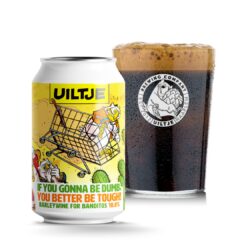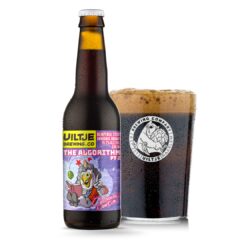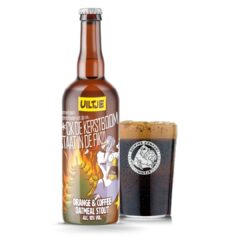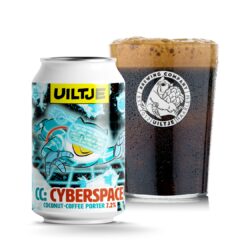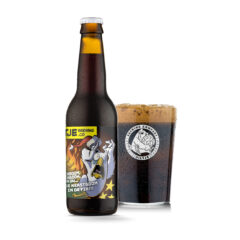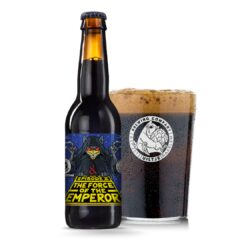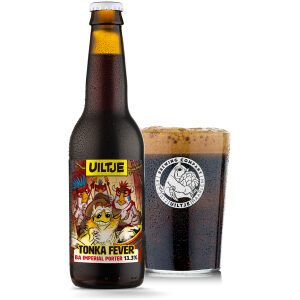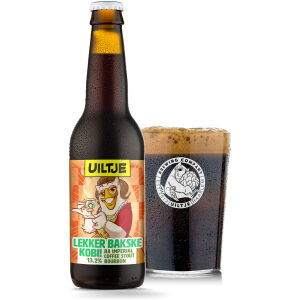Stout & Porter beers
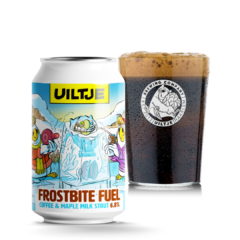
So if you are a fan of dark and strong beers, then you are on the right page! Don’t expect standard stouts and porters from us, but rather beers that push the boundaries and sometimes go beyond them; rich flavours, high alcohol percentages and unusual ingredients. Order our stouts and porters now online, and be surprised by a ‘bittersweet symphony’ of flavours and aromas!
Brewed traditionally with dark malts such as black and brown malt as well as using an ale yeast means this is usually a hearty beer with lovely chocolatey coffee nutty flavours. Averaging at 5% ABV, it makes for the perfect session beer too!
Discover our special stouts and porters
Stouts and porters are traditional beer styles that you can write pages about. That’s what we have also done: head over to the relevant pages for more information about the origin and development of stout and porter. There you can read more about the typical mouthfeel and the characteristic aromas of these beers. For now it is important to know that whilst we respect the traditions, we like to give them our own twist. In addition to the well-known ingredients, we add, for example, marshmallows, vanilla, coconut or pepper, to create a flavour explosion in your mouth. Taste our stouts and porters for yourself!
Discover the stouts and porters from Uiltje Brewing
At Uiltje we are mainly known for our hop-driven beers, but we also have a wide range of stouts and porters. For example, think of our imperial stouts from the Grandson and Mind Your Step series. Or take our favourite Christmas beer, F*ck the Christmas tree is on fire!, an orange & coffee oatmeal stout. In addition to these recurring beers, we regularly brew other stouts and porters, such as milk stouts, English porters, Baltic porters and American porters. Keep an eye on this page if you want to order some special dark beers!
Looking for more than porters and stouts?
Would you like to discover more great beers besides porters and stouts? Then have a look through our online beer shop. Would you like to try even more strong and dark beers? Then head to our barrel-aged section. Or are you ready for something fresh and hoppy after all those dark roasted flavours? Then try our popular IPAs and fruity beers.
Why buy your porters and stouts online from Uiltje Brewing?
Buying your porters and stouts online from Uiltje means that you buy directly from the source. We can tell you everything about our beautiful beers and send them directly to you. Take the time to read our product descriptions and make a choice. Would you rather receive some personal advice? Feel free to contact one of your fellow beer-lovers here at Uiltje!
For an incredibly dark beer, Porter beer certainly has a colourful history. Not only are Porters associated with the birth of the popular Stout beer style, they also helped to transform the brewing landscape in London, quenching the thirst of hard-working labourers in the British capital.
History of Porter Beer
Interestingly one could say porter beer was born out of convenience rather than anything else. Like many things in beer history, there is always some speculation as to how true the stories are but the following is what many agree to be the most accurate version of events. Going back to 18th Century London, at the time it was common for pub landlords to serve mixed pints, consisting of three different kinds of beer – usually Pale, Brown and Old Ale – called ‘Three Threads’. It was very popular amongst beer drinkers and it was a rather convenient way for landlords to use up their old beer.
A local brewer in Shoreditch, East London, allegedly went on to develop a recipe that would replicate the above beer which was called ‘Entire Butt’ (in reference to a large cask). Like we’ve said there is some debate as to how true all of this is, and many have stated that this ‘Entire Butt’ was rather more likely based on the highly popular Brown Ales of the time, but hey don’t let the truth get in the way of a good story right? At the time these beers were not only brewed with dark malts but were also well hopped – the stronger versions were labelled as stout porters, which as you might have guessed, eventually led to the stout as a beer style of its own! Nevertheless, this beer, dubbed Porter, as it was largely consumed amongst these men (porters were folks who would carry goods across London) became incredibly popular and soon it was all that the local breweries were producing! In fact, one brewery had such large vessels to store Porter that when one collapsed, eight unfortunate souls drowned in beer!
Colour of a Porter Beer
Just like a stout, a porter beer is usually as dark as can be. However, don’t be mistaken that it should be completely black and opaque. Brewed with black and brown malts means that whilst it might look like a black beer, if you hold up your porter against the light you should see that it can vary from being a light brown to a dark brown. In fact, some of the lighter porters available can even be a deep ruby colour rather than dark brown, but this is less common. Just like a stout, depending on the brew, porters can also have a nice creamy head making it an overall a very enticing looking beer!
Different types of Porter Beer
It would be boring if there was only one kind of porter available to drink but luckily, over the years the beer style has evolved and nowadays you can find an array of different kinds of porter. Let’s begin with the classic brown porter, the most traditional kind out there and the one you will have most likely tried if you’ve enjoyed a porter before. Usually lower in alcohol at 4-5% this is a nice session porter, perfect to drink away on an afternoon or evening or at any time really! A Robust porter is a slightly stronger version of the classic brown porter and some may associate it with the ones that have been produced more recently by craft brewers, experimenting with higher ABVs as well as with American hops.
If you’re looking for something even stronger then how about a Baltic porter? As the name illustrates, these became popular throughout the Baltic states and differ from the other two types in that they’re usually brewed with a lager yeast but at warmer fermentation temperatures, resulting in a cleaner finish. However, averaging at 8-9% with some stronger than 10%, this is a hardy porter and bound to warm you up on a cold wintery day!
Porter Beer Food Pairing
The great thing about a porter and its strong chocolate coffee like flavours is that you don’t need to shy away when food pairing. Just like with a stout, it is the perfect accompaniment to red meats such as your burgers and sausages! Perfect if you’re thinking of firing up the bbq!
Beer and cheese pairing has become increasingly popular over the years and porter should be no exception especially so if you’ve got a porter with nutty flavours, it will complement your nutty cheeses too. If this still doesn’t tickle your fancy then perhaps something for your sweet tooth? Porter and chocolate cake has been described as being the ultimate pudding combo as they share many of the same flavours and as such complement each other perfectly!
Porter Beer at Uiltje Brewing Company
So, what do we have for porters here at Uiltje? Well for a brewery that usually specialises in hoppy fresh IPAs you’ll be reassured to hear that we have also dipped our toe into the world of dark beers. Over the years, we have brewed porters that have been immensely popular including the Matryoshka Doll, a Baltic Porter at 7.5% and if you were lucky enough to come across our Meneer de Uil Barrel series you’ll have noticed that we did a barrel aged porter too. Whilst we haven’t got any porters being brewed at this moment in time, if you are a big fan of the darker beers then we would recommend that you check out our range of available stouts too. Head to our website and if you take a look at our beer release calendar, you’ll notice that we have got a range of stouts due to be released through our Mind your Step series as well as our Grandson series. These are usually higher strength stouts and brewed with all sorts of crazy ingredients, they will certainly keep you entertained. These delicious stouts will hopefully keep you going until we do release a porter once more!
What is a Stout Beer?
Funnily enough, you could probably define a stout beer by the kind of person who would’ve drunk them back in the day – a well-built strong bloke, enjoying it after an arduous day at work. And that’s exactly what a stout is, a hefty top-fermented beer, with many joking that you could have one as a meal.
Whilst they were traditionally stronger kinds of beer at 7-8% rather than dark beer, they are today the darkest kind of beer that you’ll find out there, and as such the focus on this beer is on the kind of malts that we use, rather than the hops.
History of Stout Beer
When you think of the history of stout beer, the first thing that will most likely pop into your head is Guinness, the famous Irish stout from Dublin. However, stouts actually originate from London and derive from another well-known beer style, Porters. First brewed in the 18th Century, these strong beers quickly became very popular, especially with London street porters, which is, you guessed it, where it got its name from. Porters became so popular that for many breweries this was the only kind of beer they brewed, however different strengths of porter were brewed. Stout porters were thus a stronger version of this beer and soon their name was shortened to just stout. These beers were soon being exported and proved to be also very popular in Ireland. Keen not to miss out, a certain Arthur Guinness soon started brewing his own version, a Dry Irish Stout at his St James’s Gate Brewery in Dublin, which through the use of roasted barley rather than malted barley created a drier and more bitter flavours in the stout.
Today you will still hear many brewers and beer drinkers debate stouts and porters and whether they’re the same or differ. This largely depends on how it’s been brewed as porters tend to be lighter than stouts. Many will also differentiate between the two geographically, with porters being associated with London and stouts, not surprisingly, with Dublin.
Colour of a Stout Beer
You shouldn’t be surprised by now to hear that stout beers are usually the darkest of beers that you can find out there and as we’ve said above, this is all thanks to the malt that we use when we brew a stout. Stouts are brewed with incredibly dark malts that have been heavily kilned or roasted. Though it will look black in colour, if you hold your stout against the light you’ll see that it’s usually an incredibly dark brown or even ruby in colour. Depending on how the beer is dispensed, many stouts will also have a lovely creamy white head, providing a wonderful stark contrast to the dark body of the beer. These malts don’t just give you the colour, they’ll give you those lovely bitter chocolate coffee burnt flavours too!
Different types of Stout Beer
Many beer styles enjoy sub categories and stouts are no different. You’ll find that an array of different kinds of stouts have been brewed over the years, with many still proving to be popular today. For instance, we have dry stouts, which is what Guinness is brewed as, which as the name suggests, are drier and more bitter in flavour. Need a breakfast beer? Then how about an oatmeal stout? Brewed with usually 30% oats in the grist bill this will give your beer a lovely creamy smooth texture. Milk stouts are another wonderful kind of stout and have proven popular once again thanks to Craft brewers. Brewed with lactose, these stouts are sure to be silky smooth compared to its counterparts.
Or if you fancy something a little different, how about an oyster stout? This has been brewed in the past with literal oysters going into the stout, and whilst today oysters are no longer in the brew itself, you will find many breweries still brew an oyster stout, including here in the Netherlands (we’ve even done one here at Uiltje!).
For the hardcore beer drinkers, there is also the option of an imperial stout, with average ABV’s of over 10%, this kind of stout is perhaps best saved for the end of the night!
Stout Beer Food Pairing
Many joke that you can enjoy a stout as a meal, and whilst this is true, they also make a great food accompaniment. As we’ve said above, back in the day some stouts were brewed with oysters in them but if that doesn’t tempt you, then try eating oysters with a stout on the side – the saltiness of the oysters will complement the chocolatey coffee flavours of the stout. If however you are not a fan of oysters, stouts are great with a burger or steak and fries, basically your juicy red meats! Also perfect if you’re thinking of having a BBQ and need a good beer to go with it. If you want to try something a little different, you could even try baking with it – stout brownie anyone?
Stout Beer at Uiltje Brewing Company
Now you would be forgiven for thinking that here at Uiltje, we’re all about IPAs and super fresh beers and whilst this is true, this nevertheless hasn’t stopped us from producing some scrumptious stouts. Our hardcore fans should by now be familiar with F*ck the Christmas tree is on fire!, an orange and oatmeal stout which we release at the beginning of winter, and at 10%, it is indeed a fantastic winter warmer. Though we’ve been brewing it for a few years, it still remains a firm favourite for both the brewers and our Uiltje fans. More recently we’ve been stepping up our production with stouts, experimenting with different ingredients along the way. These are released through our Mind Your Step series for those of you who are looking for a stout with a twist as well. And if this isn’t enough then be sure to keep an eye on our new Grandson series for even wackier stouts! Need to quench your thirst? Then check out the beer release calendar to see when we’re releasing our next stout!
